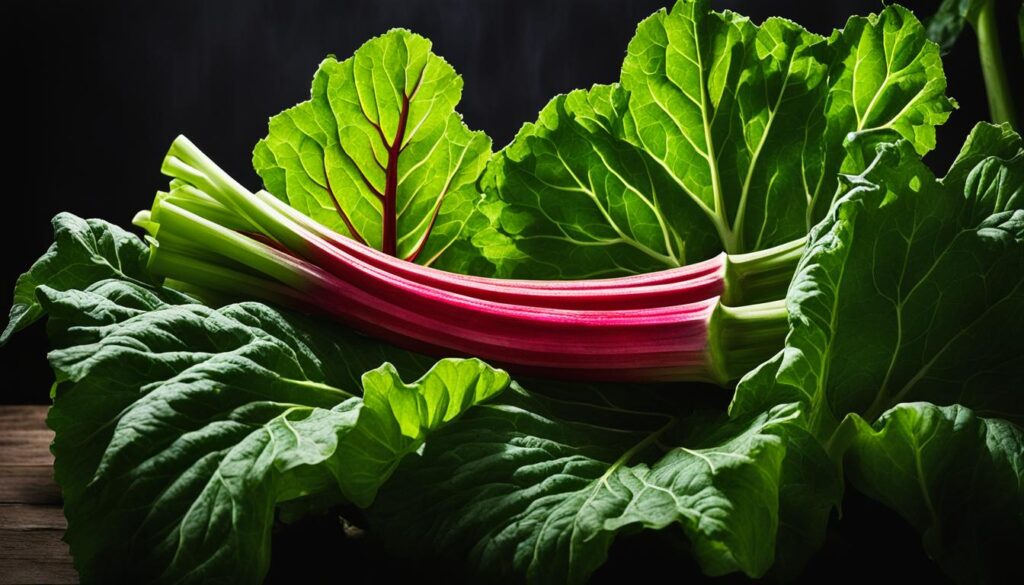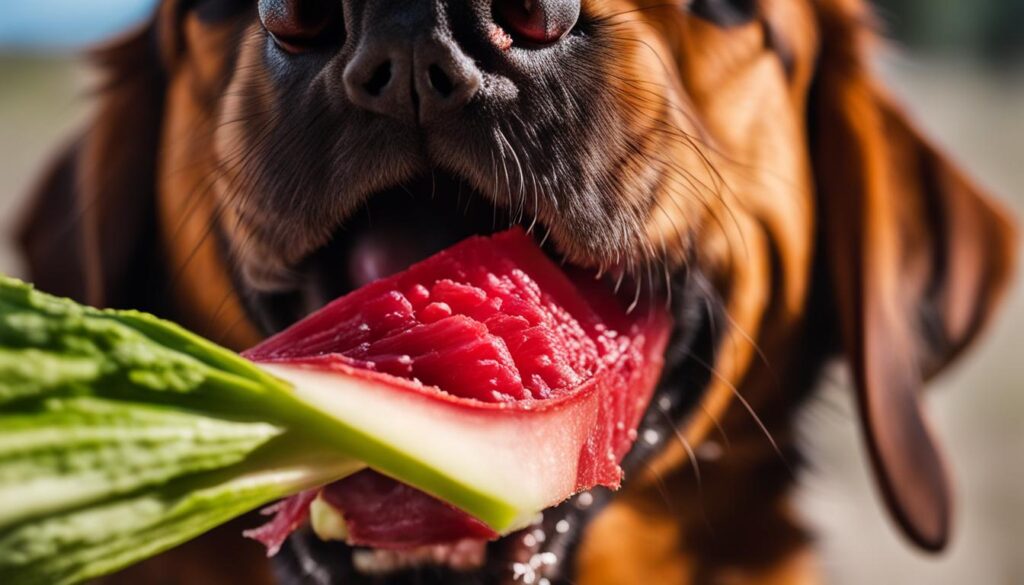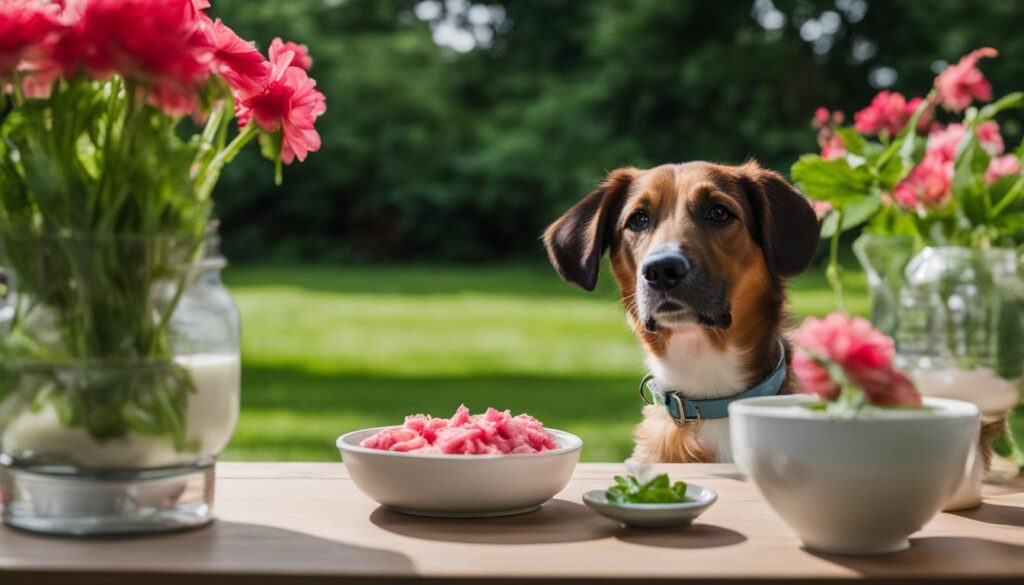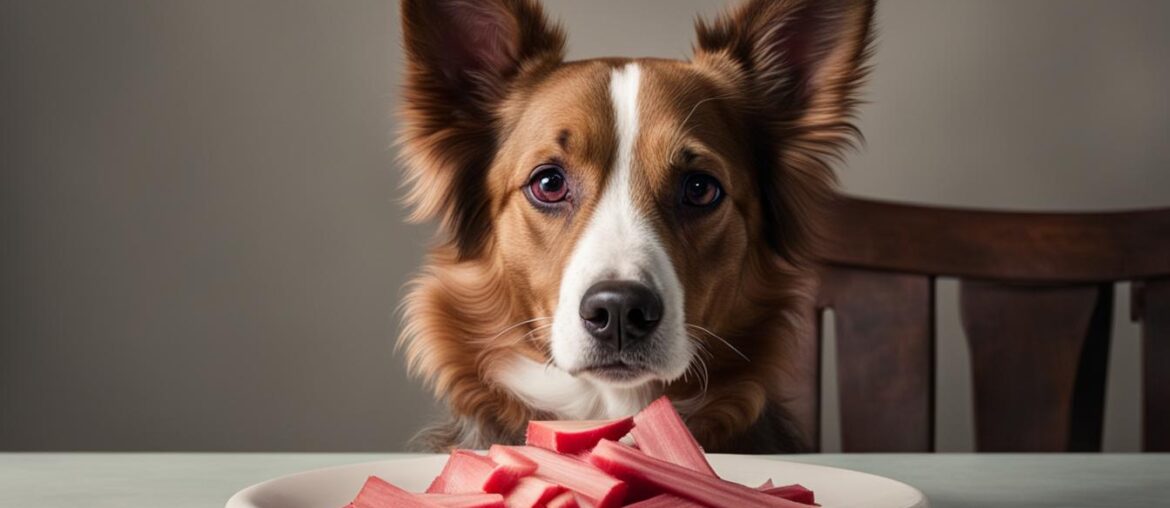As a pet owner, it’s essential to be cautious about the foods you feed your furry friend. One particular food that may raise some questions is rhubarb. So, can dogs eat rhubarb? Let’s dive into this topic and explore whether rhubarb is safe for dogs to eat and the potential risks associated with giving it to them.
Key Takeaways:
- Rhubarb is considered mildly toxic to dogs and should be avoided in their diet.
- The leaves of the rhubarb plant are highly toxic and can cause significant health issues if ingested by dogs.
- Even though the stalks of rhubarb are safer than the leaves, they can still cause gastrointestinal upset in dogs.
- Raw or cooked rhubarb, including rhubarb yogurt, should not be given to dogs as they can be harmful.
- Rhubarb does not offer significant nutritional benefits to dogs, so it’s best to focus on a complete and balanced diet for their well-being.
Can Dogs Eat Rhubarb Leaves? The Dangers of Rhubarb Consumption

When it comes to rhubarb, dogs should steer clear of the leaves. Rhubarb leaves are highly toxic to dogs and can pose serious health risks if ingested. They contain soluble calcium oxalate crystals and oxalic acid, which can cause pain, swelling, and irritation in dogs’ mouths. Ingesting these leaves can lead to gastrointestinal symptoms such as vomiting, diarrhea, and loss of appetite. In severe cases, it can even cause kidney failure.
To ensure the safety of your furry friend, it is important to keep your dog away from rhubarb plants and ensure they do not have access to the leaves. This can be achieved by securing your garden area or supervising your dog during outdoor activities. Additionally, it is crucial to educate yourself and your family members about the potential dangers of rhubarb leaves to dogs.
Remember, prevention is key when it comes to protecting your dog’s health. By keeping them away from rhubarb leaves, you can avoid potential risks and ensure their well-being.
| Potential Risks of Giving Rhubarb Leaves to Dogs |
|---|
| Highly toxic to dogs |
| Contain soluble calcium oxalate crystals and oxalic acid |
| Can cause pain, swelling, and irritation in dogs’ mouths |
| May lead to gastrointestinal symptoms such as vomiting, diarrhea, and loss of appetite |
| In severe cases, can result in kidney failure |
Can Dogs Eat Rhubarb Stalks? The Safety of Rhubarb Stems
While rhubarb stalks are considered safer for dogs compared to the leaves, it’s important to note that they still contain calcium oxalate crystals, which can pose potential risks to your furry friend. Consumption of rhubarb stalks can lead to stomach upset and discomfort in dogs.
It is advisable to prevent your dog from eating any part of the rhubarb plant, including the stalks. While some dog owners may argue that their dogs have consumed rhubarb stalks without any immediate adverse effects, it’s essential to prioritize your pet’s well-being and avoid unnecessary risks.
Feeding your dog a nutritionally balanced diet that meets their specific dietary requirements is crucial for their overall health and happiness. Rhubarb does not offer significant health benefits for dogs, and there are other safe and healthy treat alternatives available.
Remember, the safety of your dog should always be a top priority. If you suspect that your dog has ingested rhubarb or is experiencing any symptoms of rhubarb toxicity, it is important to consult with a veterinarian for proper guidance and treatment.
Can Dogs Eat Raw Rhubarb? The Risks of Raw Rhubarb Consumption

Dogs should not eat raw rhubarb as it can cause gastrointestinal upset and discomfort. Raw rhubarb contains high levels of oxalic acid, which can be harmful to dogs when ingested. It is important to cook rhubarb before feeding it to your dog to minimize the risks.
Rhubarb is a plant that contains calcium oxalate crystals, which can irritate a dog’s mouth, throat, and stomach. The oxalic acid in raw rhubarb can lead to digestive upset, including vomiting, diarrhea, and stomach pain. Cooking rhubarb breaks down the oxalic acid and reduces its potential harm to dogs.
When preparing rhubarb for your dog, make sure to remove all the leaves and focus only on the stalks. The leaves are highly toxic and should never be consumed by dogs. Wash the stalks thoroughly and remove any tough or fibrous parts before cooking.
Potential Risks of Raw Rhubarb for Dogs:
- Gastrointestinal upset
- Vomiting
- Diarrhea
- Stomach pain
- Mouth, throat, and stomach irritation
It is crucial to cook rhubarb before feeding it to your dog to ensure their safety and well-being.
By cooking rhubarb, you can make it safer for your dog to enjoy as an occasional treat. However, it is important to keep in mind that rhubarb is not nutritionally essential for dogs and should not replace a balanced diet. Consult with your veterinarian before introducing any new food to your dog’s diet, including cooked rhubarb.
| Risks of Raw Rhubarb for Dogs | Safe Alternatives |
|---|---|
| High levels of oxalic acid | Safe fruits and vegetables: apples, blueberries, carrots |
| Gastrointestinal upset | Lean meats: chicken, turkey, beef |
| Mouth, throat, and stomach irritation | Plain cooked rice or pasta |
Can Dogs Eat Cooked Rhubarb? The Safety of Cooked Rhubarb for Dogs

Even though cooking rhubarb may make it more palatable, it does not make it safe for dogs to eat. Cooked rhubarb can still cause stomach upset in dogs, and the added sugar and spices commonly used in cooking rhubarb desserts are not healthy for dogs. It is best to avoid feeding your dog cooked rhubarb.
While it’s tempting to share our favorite rhubarb recipes with our furry friends, it’s important to remember that dogs have different nutritional needs and sensitivities compared to humans. Cooked rhubarb may be delicious for us, but it can have potential risks for dogs.
When we cook rhubarb, we often add sugar or other sweeteners to balance its tartness. However, these added sugars can be harmful to dogs and contribute to weight gain, dental problems, and even diabetes. Additionally, the spices commonly used in cooking rhubarb desserts, such as cinnamon or nutmeg, may not be safe for dogs to consume in large quantities.
It’s crucial to prioritize your dog’s health and well-being by providing them with a balanced and appropriate diet. Instead of cooked rhubarb, there are plenty of other safe and healthy treats that you can share with your canine companion.
Remember, dogs rely on their owners to make the best choices for their dietary needs. So, while you may enjoy a slice of rhubarb pie or a rhubarb crumble, it’s best to keep these treats to yourself and offer your dog something more suitable.
| Potential Risks of Giving Cooked Rhubarb to Dogs | Safe and Healthy Alternatives |
|---|---|
|
|
It’s always best to consult with your veterinarian about suitable and safe treat options for your dog. They can provide personalized recommendations based on your dog’s specific dietary needs and any existing health conditions.
Can Dogs Eat Rhubarb Yogurt? The Risks of Rhubarb-Yogurt Combination

While rhubarb yogurt may seem like a safer option compared to raw or cooked rhubarb, it still has potential risks for dogs. Rhubarb yogurt often contains concentrated lemon juice and high amounts of sugar, both of which can be harmful to dogs. Excessive sugar intake can lead to weight gain, dental problems, and even diabetes in dogs. It is best to avoid feeding your dog rhubarb yogurt and opt for healthier treat alternatives.
Why is Rhubarb Yogurt Harmful to Dogs?
Rhubarb yogurt poses risks to dogs due to its ingredients. Concentrated lemon juice, when consumed in large quantities, can cause gastric irritation and diarrhea in dogs. Additionally, the high sugar content in rhubarb yogurt can contribute to weight gain and dental issues. Excessive sugar intake can lead to obesity, which increases the risk of various health problems in dogs, including diabetes, heart disease, and joint issues.
Healthy Alternatives to Rhubarb Yogurt
Instead of feeding your dog rhubarb yogurt, consider offering them healthier treat options. Here are some alternatives:
- Natural yogurt without any added sugar, flavors, or additives
- Plain, cooked rhubarb without added sweeteners
- Frozen fruits like strawberries, blueberries, or watermelon (in moderation)
- Carrot sticks or apple slices (ensure no seeds or core are included)
| Treat | Description | Suitable for Dogs? |
|---|---|---|
| Natural yogurt | Plain yogurt without added sugar or artificial flavors | Yes |
| Cooked rhubarb | Rhubarb cooked without added sweeteners | In small quantities |
| Frozen fruits | Strawberries, blueberries, or watermelon without any additives | Only in moderation |
| Carrot sticks | Fresh carrots cut into small, bite-sized pieces | Yes |
| Apple slices | Fresh apple slices without seeds or the core | Yes |
Remember, it’s important to introduce new treats gradually and monitor your dog’s overall diet to ensure they receive balanced nutrition. If you have any concerns or questions about your dog’s diet, consult with your veterinarian for professional advice.
By choosing safe and nutritious alternatives, you can provide your dog with treats that promote their well-being without exposing them to the potential risks associated with rhubarb yogurt.
The Health Benefits of Rhubarb (For Humans, Not Dogs)

While rhubarb offers some nutritional benefits, it is important to note that these benefits are more relevant to humans than to dogs. Rhubarb contains fiber, vitamin C, and minerals like potassium, manganese, and magnesium. However, these nutrients are not essential for dogs, and there are better alternatives available to meet their nutritional needs.
Rhubarb is not considered a staple food for dogs and does not offer significant health benefits when included in their diet. In fact, the limited nutritional value of rhubarb for dogs is outweighed by the potential risks associated with its consumption.
Feeding rhubarb to dogs can lead to gastrointestinal upset, digestive issues, and other health problems. Dogs may experience symptoms such as vomiting, diarrhea, and loss of appetite after consuming rhubarb. Additionally, rhubarb contains oxalic acid and calcium oxalate crystals, which can be harmful to dogs.
To ensure the well-being of your dog, it is best to avoid feeding them rhubarb and choose safer and healthier food options instead. A balanced and complete diet formulated specifically for dogs will provide them with all the necessary nutrients they need to thrive.
Remember, what may be beneficial for humans may not necessarily be beneficial or safe for dogs. It is always best to consult with a veterinarian regarding your dog’s diet and nutrition to ensure they are receiving the appropriate food for their overall health and well-being.
References:
- Rhubarb Benefits: Nutrition and Risks. Healthline. Accessed February 15, 2022. https://www.healthline.com/nutrition/rhubarb-benefits
| Nutrient | Rhubarb (For Humans) | Dogs’ Nutritional Needs |
|---|---|---|
| Fiber | High in fiber, beneficial for digestion | Required for digestive health, but can be obtained from other sources |
| Vitamin C | Good source of vitamin C, boosts immunity | Not essential, as dogs can produce their own vitamin C |
| Potassium | Contains potassium, important for heart health and muscle function | Essential for dogs, but can be obtained from other sources |
| Manganese | Provides manganese, supports bone health and metabolism | Required in smaller amounts, but can be obtained from other sources |
| Magnesium | Contains magnesium, important for nerve and muscle function | Essential for dogs, but can be obtained from other sources |
The Toxicity of Rhubarb to Dogs

Rhubarb is considered to have mild to moderate toxicity levels for dogs. The calcium oxalate crystals present in the plant can be irritants to dogs, causing pain, swelling, and digestive issues. Ingesting large amounts of rhubarb or other foods with high oxalate content can lead to kidney or bladder stones, and in severe cases, kidney failure. It is crucial to keep your dog away from rhubarb plants and prevent any accidental ingestion.
| Symptoms of Rhubarb Toxicity in Dogs |
|---|
| Drooling |
| Loss of appetite |
| Vomiting |
| Diarrhea |
| Lethargy |
| Weakness |
| Tremors |
| Bloody urine |
| Changes in thirst and urination patterns |
Symptoms of Rhubarb Toxicity in Dogs
If a dog ingests rhubarb, they may exhibit various symptoms that indicate potential rhubarb toxicity. These symptoms include:
- Drooling
- Loss of appetite
- Vomiting
- Diarrhea
- Lethargy
- Weakness
- Tremors
- Bloody urine
- Changes in thirst and urination patterns
If your dog shows any signs of rhubarb ingestion and exhibits these symptoms, it is essential to seek immediate veterinary care for proper diagnosis and treatment.
Remember, being aware of these symptoms can help you detect and address potential rhubarb toxicity in your dog promptly.
| Symptom | Description |
|---|---|
| Drooling | Excessive production of saliva from the mouth |
| Loss of appetite | Reduction or absence of desire to eat |
| Vomiting | Forceful expulsion of the stomach’s contents through the mouth |
| Diarrhea | Passing loose, watery stools |
| Lethargy | Extreme tiredness or lack of energy |
| Weakness | Lack of strength in the body |
| Tremors | Involuntary shaking or trembling |
| Bloody urine | Presence of blood in the urine |
| Changes in thirst and urination patterns | Altered drinking and peeing habits |
Keeping Dogs Safe from Rhubarb
To ensure your dog’s safety, it is crucial to keep them away from rhubarb plants. Rhubarb contains substances that can be harmful to dogs, especially the leaves and other parts of the plant. Here are some steps you can take to keep your dog safe from rhubarb:
- Fence off the rhubarb plants: Use fencing or other barriers to prevent your dog from accessing the rhubarb plants in your garden. This will physically restrict your dog’s access to the plants and reduce the risk of ingestion.
- Keep an eye on your dog: Supervise your dog when they are outdoors to ensure they do not approach or consume any rhubarb plants. If you notice your dog showing interest in the plants, redirect their attention to a safe and appropriate activity.
- Teach your dog to “leave it”: Train your dog to respond to the “leave it” command. This command can help redirect their attention away from potentially harmful plants like rhubarb.
- Educate yourself and your family: Learn about the potential dangers of rhubarb and communicate them to your family members. Everyone should understand the importance of keeping rhubarb away from pets, especially dogs.
By implementing these measures, you can create a safe environment for your dog and prevent any accidental consumption of rhubarb.
| Risk Factors | Preventive Measures |
|---|---|
| Dog’s curiosity and access to rhubarb plants | Use fencing or barriers to restrict access |
| Unattended outdoor time | Supervise your dog when outdoors |
| Lack of training | Teach your dog the “leave it” command |
| Lack of awareness | Educate yourself and your family about the dangers of rhubarb |
Wrapping Up
In conclusion, it is not safe for dogs to consume rhubarb. The various parts of the rhubarb plant, including the leaves and stalks, contain calcium oxalate crystals that can cause gastrointestinal issues and other health problems in dogs. Rhubarb consumption can lead to symptoms such as vomiting, diarrhea, and even kidney failure in severe cases.
It is crucial to prevent your dog from accessing rhubarb plants and avoid feeding them any form of rhubarb, including raw, cooked, or in yogurt. While rhubarb may offer some nutritional benefits for humans, it is not suitable for dogs and does not provide any significant health advantages. Instead, focus on feeding your dog a complete and balanced diet that meets their nutritional needs.
If you suspect your dog has ingested rhubarb or shows any signs of rhubarb toxicity, it is important to seek immediate veterinary care. A veterinarian can provide the necessary diagnosis and treatment to ensure your dog’s well-being. Always prioritize your dog’s safety and consult with a professional for any concerns or questions regarding their diet and potential exposure to toxic substances.
| Key Points | Summary |
|---|---|
| Rhubarb is mildly toxic to dogs | Dogs should not consume rhubarb due to the potential risks and toxicity of the plant. |
| Calcium oxalate crystals | The leaves and stalks of rhubarb contain calcium oxalate crystals, which can cause digestive issues and kidney problems in dogs. |
| Gastrointestinal symptoms | Ingesting rhubarb can lead to symptoms such as vomiting, diarrhea, and loss of appetite in dogs. |
| Rhubarb yogurt is not safe | Even rhubarb yogurt can pose risks to dogs due to added sugar and potential ingredients like concentrated lemon juice. |
| Veterinary care | If you suspect rhubarb ingestion or notice any symptoms, consult with a veterinarian for proper diagnosis and treatment. |
FAQ: Can dogs eat rhubarb?
While rhubarb is a popular ingredient in human dishes and desserts, it is important to understand that dogs should not eat rhubarb. The leaves, stalks, and other parts of the plant contain calcium oxalate crystals that can be harmful to dogs. These crystals can cause gastrointestinal illness and other symptoms such as vomiting, diarrhea, and loss of appetite. In severe cases, they can even lead to kidney failure.
Raw or cooked rhubarb, including rhubarb yogurt, should be avoided when it comes to feeding your furry friend. Both raw and cooked rhubarb can cause stomach upset and discomfort in dogs. Additionally, cooked rhubarb often contains added sugar and spices, which are not healthy for dogs, and rhubarb yogurt may also contain concentrated lemon juice.
It is essential to keep your dog away from rhubarb plants and ensure they do not have access to any part of the plant, including leaves and stalks. If you suspect your dog has ingested rhubarb or shows any symptoms of rhubarb toxicity, it is crucial to seek veterinary care immediately. Always prioritize your dog’s safety and consult with a veterinarian for specific dietary recommendations and guidance.
FAQ
Can dogs eat rhubarb leaves?
No, dogs should not eat rhubarb leaves. Rhubarb leaves contain calcium oxalate crystals and other toxins that can cause gastrointestinal illness, kidney problems, and other health issues in dogs. It is important to keep your dog away from rhubarb plants and prevent any ingestion of the leaves.
Can dogs eat rhubarb stalks?
While rhubarb stalks are safer for dogs compared to the leaves, they should still be avoided. Rhubarb stalks contain calcium oxalate crystals that can cause stomach upset and discomfort in dogs. It is best to prevent your dog from eating any part of the rhubarb plant, including the stalks.
Can dogs eat raw rhubarb?
No, dogs should not eat raw rhubarb. Raw rhubarb contains high levels of oxalic acid, which can be harmful to dogs. It can cause gastrointestinal upset and discomfort. It is important to cook rhubarb before feeding it to your dog to minimize the risks.
Can dogs eat cooked rhubarb?
It is best to avoid feeding your dog cooked rhubarb. While cooking rhubarb may make it more palatable, it does not make it safe for dogs to eat. Cooked rhubarb can still cause stomach upset, and the added sugar and spices commonly used in cooking rhubarb desserts are not healthy for dogs. It is best to choose other treat alternatives for your dog.
Can dogs eat rhubarb yogurt?
It is not recommended to feed your dog rhubarb yogurt. Rhubarb yogurt often contains concentrated lemon juice and high amounts of sugar, both of which can be harmful to dogs. Excessive sugar intake can lead to weight gain, dental problems, and even diabetes in dogs. It is best to avoid feeding your dog rhubarb yogurt and opt for healthier treat alternatives.
Are there any health benefits of feeding rhubarb to dogs?
Rhubarb is not particularly nutritious for dogs and does not offer significant health benefits. While it contains some fiber, vitamin C, and minerals like potassium, manganese, and magnesium, these nutritional benefits are more relevant to humans. It is best to feed your dog a complete and balanced diet that provides wholesome nutrition instead.
Is rhubarb toxic to dogs?
Rhubarb is considered mildly toxic to dogs. The leaves, stalks, and other parts of the plant contain calcium oxalate crystals that can be irritants to dogs, causing pain, swelling, and digestive issues. Ingesting large amounts of rhubarb or other foods with high oxalate content can lead to kidney or bladder stones, and in severe cases, kidney failure. It is crucial to keep your dog away from rhubarb plants and prevent any accidental ingestion.
What are the symptoms of rhubarb toxicity in dogs?
If a dog ingests rhubarb, they may exhibit symptoms such as drooling, loss of appetite, vomiting, diarrhea, lethargy, weakness, tremors, bloody urine, and changes in thirst and urination patterns. These symptoms indicate potential rhubarb toxicity and require immediate veterinary care. It is important to be aware of these symptoms and seek medical attention if your dog shows any signs of rhubarb ingestion.
How can I keep my dog safe from rhubarb?
To ensure your dog’s safety, it is crucial to keep them away from rhubarb plants. If you have rhubarb growing in your garden, make sure it is inaccessible to your dog. This can be done by using fencing or other barriers to prevent your dog from reaching the plants. Additionally, it is important to educate yourself and your family members about the potential dangers of rhubarb and the importance of keeping it away from pets.
Can dogs eat rhubarb as a treat?
No, rhubarb should not be given to dogs as a treat. It is considered mildly toxic to dogs and can cause gastrointestinal issues, kidney problems, and other health complications. It is best to choose safe and dog-friendly fruits and vegetables as treat alternatives for your dog.






